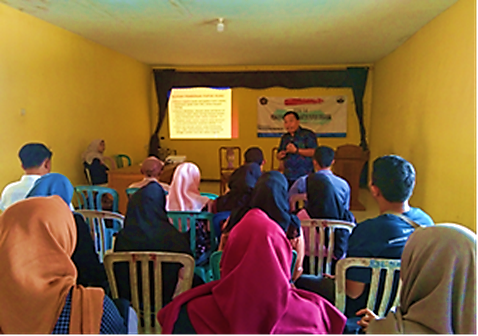Pelatihan Pembuatan Pupuk Organik dari Feses Kambing di Dau Malang Training on Organic Fertilizer Manufacturing from Goat Stool in Dau Malang
Main Article Content
Abstract
Selorejo village is famous for its sweet orange picking tours, this is because the majority of Selorejo villagers are orange farmers. The problem is to increase the quantity of citrus production, farmers in the village of Selorejo generally use chemical fertilizers while the abundance of goat manure in the village is wasted without being able to process it into compost. The purpose of this community service is to implement science and technology in the form of making organic fertilizer from goat manure as an effort to increase orange production. This activity was carried out in Selorejo Village, Dau District, Malang Regency. The method used in this activity is an education in the form of counseling and training. The results of community service activities are, first, the community has increased knowledge (41.1%) about the importance of organic fertilizer in citrus cultivation. Second, there is an increase in skills (58%) in making organic fertilizer from goat manure. Third There is a change in attitude (49.1%) towards the use of organic fertilizer from goat manure. While the goat manure produced has met SNI standard 19-7030-2004.
Downloads
Article Details
Authors who publish with this journal agree to the following terms:
- Any article on the copyright is retained by the author(s).
- Author grant the journal, right of first publication with the work simultaneously licensed under a Creative Commons Attribution License that allows others to share work with acknowledgment of the work authors and initial publications in this journal.
- Authors are able to enter into a separate, additional contractual arrangements for non-exclusive distribution of published articles of work (eg, post-institutional repository) or publish it in a book, with acknowledgment of its initial publication in this journal.
- Authors are permitted and encouraged to post their work online (e.g., in institutional repositories or on their websites) prior to and during the submission process, as can lead to productive exchanges, as well as earlier and greater citation of published work.
- The article and any associated published material is distributed under the Creative Commons Attribution-ShareAlike 4.0 International License
References
Gunawan, A., Surdiyanto, Y. 2001. Pembuatan kompos dengan bahan baku kotoran sapi. Media Peternakan. 24(3):12-17.
Hartatik, W.H., Husnain, Widowati, L.R. 2015. Peranan Pupuk Organik dalam Peningkatan Produktivitas Tanah dan Tanaman. Jurnal Sumberdaya Lahan. 9(2):107-120. http://dx.doi.org/10.2017/jsdl.v9n2.2015.%25p
Lingga, P., Marsono. 2000. Petunjuk Penggunaan Pupuk. Jakarta: Penebar Swadaya.
Mahatmanti, F.W., Lestari, P., Wulandari, R.S. 2011. Pemanfaatan Kotoran Kambing Sebagai Pupuk Kompos Untuk Meningkatkan Kebersihan Lingkungan Di Kelurahan Mangunsari Kecamatan Gunungpati Kota Semarang. Jurnal Abdimas. 15(2):75-80.
Mustaqim. 2001. Psikologi Pendidikan. Yogyakarta: Pustaka Pelajar.
Neoriky, R., Lukiwati, D.R., Kusmiyati, F. 2017. Pengaruh pemberian pupuk anorganik dan organik diperkaya N, P organik terhadap serapan hara tanaman selada (Lactuca sativa. L). Journal of Agro Complex (JOAC). 1(2):72-77. https://doi.org/10.14710/joac.1.2.72-77
Notoadmodjo, S. 2007. Promosi Kesehatan dan Ilmu Perilaku. Jakarta: Rineka Cipta.
Putro, B.P., Samudro, G., Nugraha, W.D. 2016. Pengaruh Penambahan Pupuk Npk Dalam Pengomposan Sampah Organik Secara Aerobik Menjadi Kompos Matang Dan Stabil Diperkaya. Jurnal Teknik Lingkungan. 5(2):1-10.
Siegel, S. 1997. Statistik Nonparametrik. Jakarta: PT. Gramedia Pustaka Utama.
Sugiyono. 2014. Metode Penelitian Kuantitatif dan Kualitatif dan R&D. Bandung: Alfabeta.
Trivana, L., Pradhana, A.Y. 2017. Optimalisasi Waktu Pengomposan dan Kualitas Pupuk Kandang dari Kotoran Kambing dan Debu Sabut Kelapa dengan Bioaktivator PROMI dan Orgadec. Jurnal Sain Veteriner. 35(1):136-144. https://doi.org/10.22146/jsv.29301
